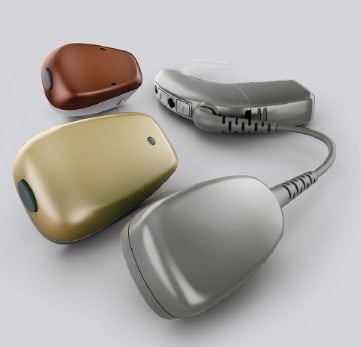Treacher Collins Syndrome or TCS is a rare genetic disorder where facial features and the skull don’t fully develop. Those who are affected by Treacher Collins Syndrome often have outer and middle ear malformations leaving them with a substantial hearing loss.
Symptoms of Treacher Collins Syndrome
The symptoms of Treacher Collins Syndrome can range from unnoticeable to severe. Some of the most common symptoms include, but are not limited to:
- Eyes that are slanted downward and away from the nose
- A small jaw (microngathia)
- Underdeveloped cheekbones
- Microtia and atresia in one or both ears
 Treacher Collins and Hearing Loss
Treacher Collins and Hearing Loss
In Treacher Collins, those with microtia almost always have a congenital aural atresia as well, which is an extremely narrow or closed ear canal and missing ear(s). Those with a closed ear canal and missing ears often times have a significant conductive hearing loss.
Conductive hearing loss is when there is damage or malformation of the outer or middle ear which blocks sound vibrations from reaching your inner ears. If you have a conductive hearing loss, your ears may feel plugged and speech may sound muffled especially in noisy environments.
Additionally, because of the missing ear canals, there is a higher chance of developing chronic ear infections and cholesteatomas since fluid, ear wax build up and dead skin cells cannot drain from the ear properly. All of which can cause further hearing loss.1
Despite having hearing loss, those with Treacher Collins typically have normal inner ear function, which makes them an ideal candidate for a bone conduction implant system.2
The Cochlear™ Baha® Implant System can help address your hearing loss if you have Treacher Collins
For over 40 years bone conduction implants have significantly changed the lives of those who struggle with single-sided deafness, conductive hearing loss and mixed hearing loss. The Baha Implant System helps you hear through direct bone conduction-which uses your body’s natural ability to conduct sound by picking up sound vibrations from the environment and then transfers the sound to a small titanium implant inserted into the bone behind your ear.
The vibrations are then sent directly through the bone to the inner ear through a process called direct bone conduction. The Baha System is an ideal solution for those who have outer or inner ear malformations since the sound bypasses the damaged part of the outer and/or middle ear sending clearer, crisper sound directly to your inner ear.3
 How the Cochlear Baha Implant System has helped others with Treacher Collins and hearing loss
How the Cochlear Baha Implant System has helped others with Treacher Collins and hearing loss
Bonnie was born with no external ears and missing ear canals due to Treacher Collins Syndrome, leaving her with a conductive hearing loss. As soon as Bonnie started to get older and become a successful professional, she felt as if something was holding her back- she never felt as if her hearing was balanced. Because Bonnie has Treacher Collins, traditional hearing aids were never an option due to not having visible ears and missing ear canals.
Finally, Bonnie learned about the life changing Baha Implant System, and her life was forever changed. Once Bonnie was fitted with the Baha 5 Sound Processors she was hearing sounds she had never heard before, including foghorns across the bay! Bonnie was amazed “how the tiny bone conduction device can bring so many sounds to me.” Learn more about Bonnie’s story and her favorite features of the Baha 5 Sound Processors.
If you or a loved one have conductive hearing loss from Treacher Collins Syndrome, discover more about how the Baha System can help.
- Treacher Collins Syndrome. (n.d.). Retrieved November 28, 2018, from https://www.californiaearinstitute.com/ear-disorders-treacher-collins-syndrome-bay-area.php
- Treacher Collins Syndrome. (n.d.). Retrieved November 28, 2018, from https://www.californiaearinstitute.com/ear-disorders-treacher-collins-syndrome-bay-area.php
- Gustafsson J. BCDrive performance vs. conventional bone conduction transducer. Cochlear Bone Anchored Solutions AB, 629908, 2015.